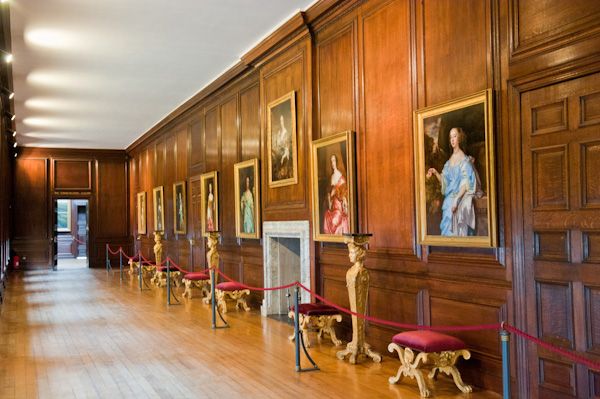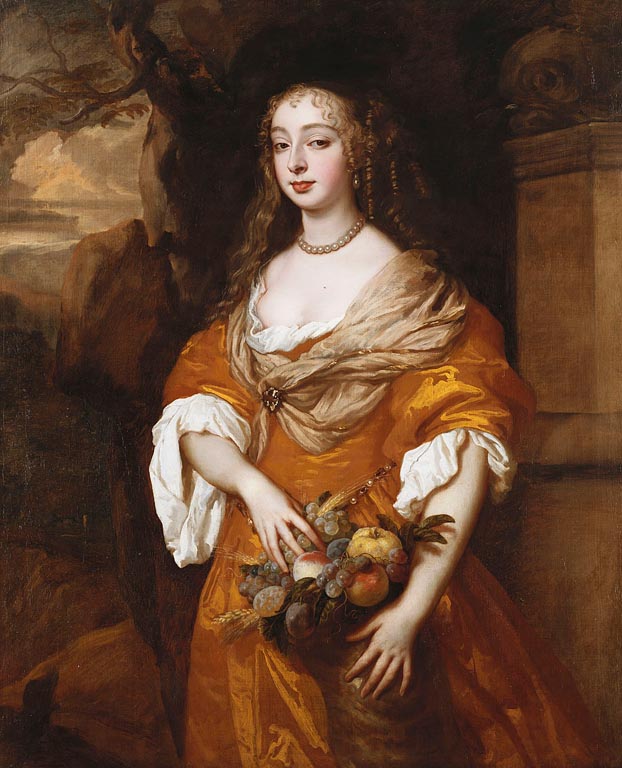Worldviews and Friendships in Portrait Painting
One of the most impressive aspects of our trip to England was seeing the rows of portraits that furnish the royal palaces. Portraits have an unavoidable link to power in their capacity to represent and even make present the figure of the ruler in this person’s absence. But in visiting the royal collections we also learned that the content of portraits can illustrate worldviews of a particular social group. Additionally, when considering paintings as physical objects that are exchanged, they can reveal friendships among the sitters.
Left: Picture of the Communication Gallery where the “Windsor Beauties” currently hang. Photograph courtesy of BritainExpress.com, http://www.britainexpress.com/photo.htm?photo=3966
Right: Sir Peter Lely (1618-80), Jane Needham, Mrs Myddleton (1646-92) ca. 1663-65. Oil on canvas. Communications Gallery, Hampton Court Palace. Photograph courtesy of the Royal Collection Trust / © Her Majesty Queen Elizabeth II 2017.
For instance, the series of eleven female portraits called the “Windsor Beauties,” now housed at Hampton Court Palace, constitutes a window into the world of bliss and luxury that developed in the court of Charles II. Commissioned by Anne Hyde, Duchess of York, and painted by Sir Peter Lely in the 1660s, the portraits are all half-length in format and show the sitters in portrait historié. This means that the sitter was disguised as a biblical, mythological, or literary figure, for the sake of entertainment. Here the frivolous worldview of female courtesans emerges in its full.
The “Windsor Beauties” entice the senses with voluptuous scenes in which luscious fabrics compete for attention with low collar. Just in case the viewer missed the point, the sitters appear either holding the flowing fabric or fingering fruits and flowers in a way that brings tactility to the core of these sensorial portrait pictures. This celebration of the beauty of the material world speaks to a naive worldview that ignored the realities of the average English subject.
Left: King’s Private Dining Room with several of the portraits commissioned by Queen Mary II, Hampton Court Palace. Photograph taken by the author.
Right: Sir Godfrey Kneller (1646-1723), Carey Fraser, Countess of Peterborough (d.1709), 1690-91. Oil on canvas. King’s Private Dining Room, Hampton Court Palace. Photograph courtesy of the Royal Collection Trust / © Her Majesty Queen Elizabeth II 2017.
Another instance of serial female portraits at Hampton Court Palace is that of Queen Mary II’s close circle of female friends. Painted between 1690 and 1691 by Sir Godfrey Kneller, this series of eight beauties differs from the previous series in its whole-length format. The sitters appear in life size scale, a format that started to become popular in this period but that remained almost exclusively used for portraying monarchs or heads of state until the late nineteenth century.
The choice of format not only adds an obvious grandeur to the figure, but it also distances the figure from the viewer. As a result, the sitters appear as integral individuals in compositions of more restrained opulence. The series hung in Queen Mary’s Water Gallery, the temporary private retreat (between April 1689 and March 1694) she occupied while the main buildings at Hampton Court Palace were being renovated. That the portraits surrounded her in her personal residence speaks of the fondness she might have felt for the females captured in the series. Queen Mary’s portrait series is as much a celebration of friendship as it is of female beauty. After Mary’s death, her husband King William III hung the series in his private dining room to remember her and her court, further emphasizing the ideas of friendship and communion.
 Thomas Gainsborough (1727-88), John Hayes St. Leger (1765-1800), 1782. Oil on canvas. Silk Tapestry Room, Buckingham Palace. Photograph courtesy of the Royal Collection Trust / © Her Majesty Queen Elizabeth II 2017.
Thomas Gainsborough (1727-88), John Hayes St. Leger (1765-1800), 1782. Oil on canvas. Silk Tapestry Room, Buckingham Palace. Photograph courtesy of the Royal Collection Trust / © Her Majesty Queen Elizabeth II 2017.
Friendship was also expressed in royal male portraiture under the patronage of George IV. As opposed to Queen Mary II’s series in which the commissioner keeps the images, George used portraits to express friendship in a different way. He entrusted Thomas Gainsborough in 1781 to paint his portrait and that of his best friend, John Hayes St. Leger, giving to St. Leger his own portrait, and keeping St. Leger’s as a reminder of his dear persona. The portrait of St. Leger, now housed at Buckingham Palace, represents the sitter in whole-length, wearing military uniform and standing in genteel relaxed attitude next to his favorite horse. Their leisurely pose recalls the intimate moments they would have spent together riding their horses, as opposed to a more formal stance when performing their official positions. This intimacy is also suggested by George IV’s gifting of his portrait to his friend, and keeping the friend’s evinces an egalitarian relationship in contrast to Queen Mary II’s retainment of the portraits for her exclusive enjoyment.
Charles Willson Peale (1741-1827), George Washington at Princeton, 1779. Oil on canvas. Photograph courtesy of the Pennsylvania Academy of Fine Arts.
In America, the tradition of portraiture as memento of friendship and expression of worldviews continued. The figure of George Washington enters the conversation of these courtesan uses of portraiture in distinct ways. He recognized the potential of this genre of portraiture to materialize friendship, but he also invested it with more political agendas. Washington appeared several times in military uniform and standing whole-length next to a horse, in the same fashion as St. Leger and George IV. Although in the same leisurely attitude, he had more pointed references to his military activity, as the depiction of a battlefield or weapons show. This evinced that he was a man of action who fought for his destiny, as opposed to the leisured British aristocrats, and it expressed his plebeian worldview. Besides this, and in order to succeed in politics, he rewarded his friends and allies with personal tokens in the form of miniature portraits painted by Charles Willson Peale in the 1770s. Portraits of Washington were one-way gifts of friendship that reminded the beholder of Washington’s affection, but also of the politics implied in the relationship. The ways in which Washington used portraits, was, therefore, not new, but he was astute in repurposing their potential to advance a political agenda. With him a new chapter in the history of portraiture began, keeping, however, open the ongoing artistic dialogue between Britain and Anglo-America.
By Alba Campo Rosillo, PhD. Candidate in Art History, University of Delaware
References:
Law, Ernest. The History of Hampton Court Palace. London G. Bell and sons, 1890.
“Three-quarters, kit-cats and half-lengths’: British portrait painters and their canvas sizes, 1625-1850.” National Portrait Gallery, London.
Ruby, Sigrid. “Love Affairs With The Founding Father. Portrait Miniatures Of George Washington. Modes Of Creation And Display.” In European Portrait Miniatures: Artists, Functions and Collections, edited by B. Pappe, J. Schmieglitz-Otten and G. Walczak. Petersberg, Kr Fulda: Michael Imhof Verlag. Petersberg: Micahel Imhof Verlag, 2014.
“Jane Needham, Mrs Myddleton (1646-92) c. 1663-65.” Royal Collection Trust, https://www.royalcollection.org.uk/collection/search#/44/collection/401211/jane-needham-mrs-myddleton-1646-92
“Carey Fraser, Countess of Peterborough (d.1709), 1690-91.” Royal Collection Trust, https://www.royalcollection.org.uk/collection/search#/16/collection/404726/carey-fraser-countess-of-peterborough-d-1709
“John Hayes St Leger (1765-1800), 1782.” Royal Collection Trust, https://www.royalcollection.org.uk/collection/search#/35/collection/405726/john-hayes-st-leger-1765-1800
“Hampton Court Palace: A New Palace.” Historic Royal Palaces, http://www.hrp.org.uk/hampton-court-palace/history-and-stories/a-building-history/a-new-palace/






Leave a Reply